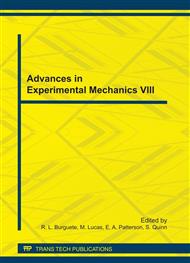p.117
p.123
p.129
p.135
p.141
p.147
p.153
p.159
p.165
Fatigue Crack Initiation and Propagation in SuperCMV Hollow Shafts with Transverse Holes
Abstract:
A fatigue crack growth test program has been carried out on hollow, SuperCMV shaft specimens, with transverse holes, under combined torsional and axial loading. The experimental results show that fatigue cracks always initiated in the stress concentration areas, i.e., in the transverse holes. Up to four cracks were observed to be initiated at different positions near the holes in the shafts. The fatigue crack propagation was initially found to occur under Mode I conditions, followed by a period of mixed Mode II/III crack growth. Three dimensional, finite element, elastic-plastic analyses have also been conducted, in an attempt to predict the crack-initiation locations and lives. The predicted crack-initiation sites agree with the experimental observations, for a range of loading conditions. The initiation sites were found to be approximately on the planes of maximum principal stress. The predicted, torque-dominated, fatigue lives of the shafts, obtained by use of a stress-life (S-N) approach, correlate reasonably well with the experimental results.
Info:
Periodical:
Pages:
141-146
Citation:
Online since:
August 2011
Authors:
Price:
Сopyright:
© 2011 Trans Tech Publications Ltd. All Rights Reserved
Share:
Citation:


